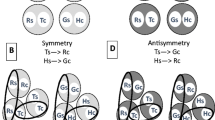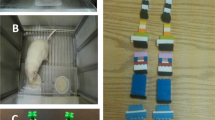Abstract
Two methodologies that have been successful in producing emergent symmetry in some nonhuman species include multiple exemplar training (sea lions) and successive conditional discrimination training of both arbitrary and key identity relations (pigeons). Two experiments were conducted to examine these procedures in rats using olfactory stimuli. In Experiment 1, sets of arbitrary conditional discriminations were trained in eight rats using a successive (go, no-go) procedure, followed by symmetry tests and then direct training of symmetry relations for four of the rats. Acquisition of bidirectional conditional discriminations was slow and limited the number of exemplars that could be trained. However, this multiple exemplar training did not result in emergent symmetry. Experiment 2 was a systematic replication of a study by Prichard et al. (Prichard et al., Journal of the Experimental Analysis of Behavior 104:133–145, 2015) that failed to find symmetry in an extension of Urcuioli’s (Urcuioli, Journal of the Experimental Analysis of Behavior 90:257–282, 2008) theory of stimulus class formation that better controlled for complications in presentation of odor stimuli. Five rats were trained on identity and arbitrary conditional discriminations with odors, then tested for emergent symmetry across eight probe sessions. Although there was some evidence for symmetry in most rats, it was ephemeral, being limited to the first few probe sessions. The search for symmetry in nonhumans continues to be elusive but using successive procedures that train arbitrary and key identity relations appears to be the more fruitful avenue in rats.





Similar content being viewed by others
References
Beurms, S., Traets, F. D., Houwer, J., & Beckers, T. (2017). Symmetry and stimulus class formation in humans: Control by temporal location in a successive matching task. Journal of the Experimental Analysis of Behavior, 108, 335–350. https://doi.org/10.1002/jeab.282
Brino, A. L., Campos, R. S., Galvão, O. F., & McIlvane, W. J. (2014). Blank-comparison matching-to-sample reveals a false positive symmetry test in a capuchin monkey. Psychology & Neuroscience, 7, 193–198. http://dx.doi.org/10.3922/j.psns.2014.008
Bujedo, J. G., García, A. G., & Fernández, V. P. (2014). Failure to find symmetry in pigeons after multiple exemplar training. Psicothema, 26(4), 435–441. https://doi.org/10.7334/psicothema2013.352
Bunsey, M., & Eichenbaum, H. (1996). Conservation of hippocampal memory function in rats and humans. Nature, 379, 255–257. https://doi.org/10.1038/379255a0
Campos, H. C., Urcuioli, P. J., & Swisher, M. (2014). Concurrent identity training is not necessary for associative symmetry in successive matching. Journal of the Experimental Analysis of Behavior, 101, 10–25. https://doi.org/10.1002/jeab.51
Dugdale, N., & Lowe, C. F. (2000). Testing for symmetry in the conditional discriminations of language-trained chimpanzees. Journal of the Experimental Analysis of Behavior, 73, 5–22. https://doi.org/10.1901/jeab.2000.73-5
Frank, A. J., & Wasserman, E. A. (2005). Associative symmetry in the pigeon after successive matching-to-sample training. Journal of the Experimental Analysis of Behavior, 84(2), 147–165. https://doi.org/10.1901/jeab.2005.115-04
Galizio, M., Mathews, M., Prichard, A., & Bruce, K. E. (2018). Generalized identity in a successive matching-to-sample procedure in rats: Effects of number of exemplars and a masking stimulus. Journal of the Experimental Analysis of Behavior, 10(3), 366–379. https://doi.org/10.1002/jeab.483
Galizio, M., & Bruce, K. E. (2018). Abstraction, multiple exemplar training and the search for derived stimulus relations in animals. Perspectives on Behavior Science, 41(1), 45-67. https://doi-org.liblink.uncw.edu/10.1007/s40614-017-0112-y
Hayes, S. C., Barnes-Holmes, D., & Roche, B. (Eds.). (2001). Relational frame theory: A post-Skinnerian account of human language and cognition. Plenum Press.
Hughes, S., & Barnes-Holmes, D. (2014). Associative concept learning, stimulus equivalence, and relational frame theory: Working out the similarities and differences between human and non-human behavior. Journal of the Experimental Analysis of Behavior, 101(1), 156–160. https://doi.org/10.1002/jeab.60
Lionello-DeNolf, K. M. (2009). The search for symmetry: 25 years in review. Learning & Behavior, 37(2), 188–203. https://doi.org/10.3758/LB.37.2.188
Lionello-DeNolf, K. M. (2021). An update on the search for symmetry in nonhumans. Journal of the Experimental Analysis of Behavior, 115, 309–325. https://orcid.org/0000-0002-5003-671X
Lionello-DeNolf, K. M., & Urcuioli, P. J. (2002). Stimulus control topographies and tests of symmetry in pigeons. Journal of the Experimental Analysis of Behavior, 78(3), 467–495. https://doi.org/10.1901/jeab.2002.78-467
Navarro, V. M., & Wasserman, E. A. (2020). Bidirectional conditioning: Revisiting Asratyan’s “alternating” training technique. Neurobiology of Learning & Memory, 171, 107211. https://doi.org/10.1016/j.nlm.2020.107211
Picanço, C. R., & Barros, R. S. (2015). Symmetry evaluation by comparing acquisition of conditional relations in successive (Go/No-Go) matching-to-sample training. The Psychological Record, 65(1), 131–139. https://doi.org/10.1007/s40732-014-0096-x
Pilgrim, C. (2020). Equivalence-base instruction. In J. O. Cooper, T. E. Heron, & W. L. Heward (Eds.), Applied behavior analysis (3rd ed.; pp. 452–496). Pearson Education.
Prichard, A., Panoz-Brown, D., Bruce, K., & Galizio, M. (2015). Emergent identity but not symmetry following successive olfactory discrimination training in rats. Journal of the Experimental Analysis of Behavior, 104(2), 133–145. https://doi.org/10.1002/jeab.169
Schusterman, R. J., & Kastak, D. (1993). A California sea lion (Zalophus californianus) is capable of forming equivalence relations. The Psychological Record, 43, 823–839. https://doi.org/10.1007/BF03395915
Sidman, M. (2000). Equivalence relations and the reinforcement contingency. Journal of the Experimental Analysis of Behavior, 74(1), 127–146. https://doi.org/10.1901/jeab.2000.74-127
Sidman, M., Rauzin, R., Lazar, R., Cunningham, S., Tailby, W., & Carrigan, P. (1982). A search for symmetry in the conditional discriminations of rhesus monkeys, baboons, and children. Journal of the Experimental Analysis of Behavior, 37, 23–44. https://doi.org/10.1901/jeab.1982.37-23
Soares Filho, P. S., Silva, Á. J., Velasco, S. M., Barros, R. S., & Tomanari, G. Y. (2016). Assessing symmetry by comparing the acquisition of symmetric and nonsymmetric conditional relations in a Capuchin Monkey. International Journal of Psychological Research, 9(2), 30–39. https://doi.org/10.21500/20112084.2320
Staubli, U., Fraser, D., Faraday, R., & Lynch, G. (1987). Olfaction and the" data" memory system in rats. Behavioral Neuroscience, 101(6), 757. https://psycnet.apa.org/doi/10.1037/0735-7044.101.6.757
Sweeney, M. M., & Urcuioli, P. J. (2010). Reflexivity in pigeons. Journal of the Experimental Analysis of Behavior, 94, 267–282. https://doi.org/10.1901/jeab.2010.94-267
Urcuioli, P. J. (2008). Associative symmetry, antisymmetry, and a theory of pigeon’s equivalence class formation. Journal of the Experimental Analysis of Behavior, 90, 257–282. https://doi.org/10.1901/jeab.2008.90-257
Urcuioli, P. J. (2011). Emergent identity matching after successive matching training, I: Reflexivity or generalized identity? Journal of the Experimental Analysis of Behavior, 96, 329–341. https://doi.org/10.1901/jeab.2011.96-329
Urcuioli, P. J. (2015). A successful search for symmetry (and other derived relations) in the conditional discriminations of pigeons. Conductual, 3, 4–25.
Urcuioli, P. J., & Swisher, M. (2012a). A replication and extension of the antisymmetry effect in pigeons. Journal of the Experimental Analysis of Behavior, 98, 283–293. https://doi.org/10.1901/jeab.2012.98-283
Urcuioli, P. J., & Swisher, M. (2012b). Emergent identity matching after successive matching training. II: Reflexivity or transitivity? Journal of the Experimental Analysis of Behavior, 97, 5–27. https://doi.org/10.1901/jeab.2012.97-5
Urcuioli, P. J., & Swisher, M. J. (2015). Transitive and anti-transitive emergent relations in pigeons: Support for a theory of stimulus-class formation. Behavioural Processes, 112, 49–60. https://doi.org/10.1016/j.beproc.2014.07.006
Velasco, S. M., Huziwara, E. M., Machado, A., & Tomanari, G. Y. (2010). Associative symmetry by pigeons after few-exemplar training. Journal of the Experimental Analysis of Behavior, 94(3), 283–295. https://doi.org/10.1901/jeab.2010.94-283
Yamamoto, J. I., & Asano, T. (1995). Stimulus equivalence in a chimpanzee (Pan troglodytes). The Psychological Record, 45(1), 3–22. https://www.proquest.com/scholarly-journals/stimulus-equivalence-chimpanzee-pan-roglodytes/docview/212761585/se-2?accountid=14606
Funding
We thank the University of North Carolina Wilmington, Center for the Support of Undergraduate Research and Fellowships (CSURF) for financial support to purchase supplies for this research.
Author information
Authors and Affiliations
Contributions
All authors contributed to study conception and design, writing, and data analysis. Katherine Dyer and Tiffany Phasukkan prepared materials and collected data as part of their master’s theses at University of North Carolina, Wilmington. Katherine Bruce and Mark Galizio synthesized and wrote the first draft of the manuscript. All authors commented on previous versions of the manuscript and all authors read and approved the final manuscript.
Corresponding author
Ethics declarations
Ethical approval
All procedures were reviewed and approved by the University of North Carolina at Wilmington Institutional Animal Care and Use Committee and conform to the National Institutes of Health Guide for the Care and Use of Laboratory Animals.
Competing Interests/Conflicts of Interest
We declare no conflicts of interest or competing interests.
Additional information
Publisher's Note
Springer Nature remains neutral with regard to jurisdictional claims in published maps and institutional affiliations.
The authors thank Sarah Accattato, Haily Kelliher, Madeleine Mason and Logan Richardson for assistance with data collection. Special thanks to Rick Shull who suggested the possibility of asymmetric trace odor compounds to us.
Supplementary Information
Below is the link to the electronic supplementary material.
Rights and permissions
About this article
Cite this article
Bruce, K., Dyer, K., Phasukkan, T. et al. Two Directions in a Search for Symmetry in Rats. Psychol Rec 72, 465–480 (2022). https://doi.org/10.1007/s40732-021-00490-x
Accepted:
Published:
Issue Date:
DOI: https://doi.org/10.1007/s40732-021-00490-x




